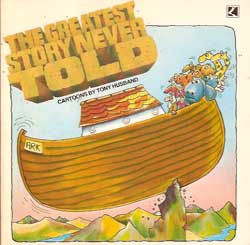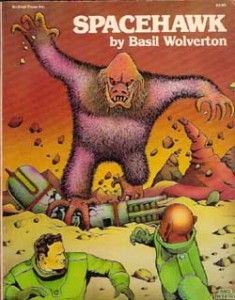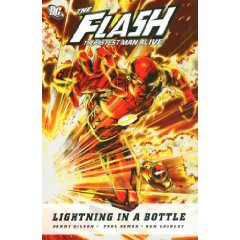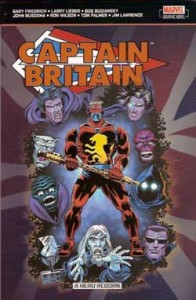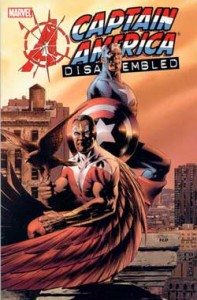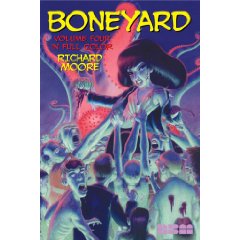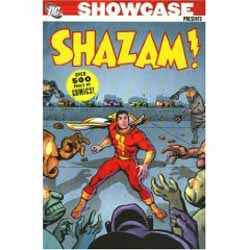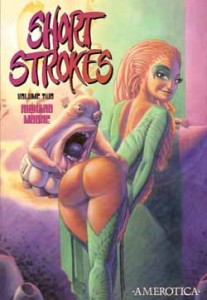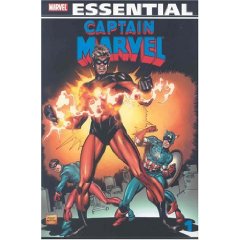
By various (Marvel)
ISBN: 978-0-7851-3059-8
By 1968 Marvel was in the ascendant. Their sales were catching up with industry leaders National (DC) Comics and Gold Key, and they had secured a new distribution deal that would allow them to expand their list of titles exponentially. Once the stars of “twin-books†Tales of Suspense, Tales to Astonish and Strange Tales each got their own title the House of Ideas just kept on creating.
One dead-cert idea was a hero named after the company – and one with some cachet and pedigree as well. After the DC/Fawcett court case of the 1940s-1950s, the name Captain Marvel disappeared from the newsstands. In 1967, during the superhero boom/camp craze generated by the Batman TV series publisher MLF secured rights to the name and produced a number of giant-sized comics featuring an intelligent robot who (which?) could divide his body into segments and shoot lasers from his eyes. Quirky and charming, devised by the legendary Carl (Human Torch) Burgos, it nevertheless did not attract a large following. On its demise the name was quickly snapped up by the expanding Marvel Comics Group.
Marvel Super-Heroes was a brand new title: it had been the giant-sized reprint comicbook Fantasy Masterpieces, comprising monster and mystery tales and latterly, Golden Age Timely Comics classics, but with the twelfth issue it added an all-new try-out section for characters without homes such as Medusa, Ka-Zar, Black Knight and Doctor Doom, and new concepts like Guardians of the Galaxy, Phantom Eagle, and, to start the ball rolling, an troubled alien spy sent to Earth from the Kree Galaxy. He held a Captain’s rank and his name was Mar-Vell.
The first 15 page instalment was by Stan Lee, Gene Colan and Frank Giacoia. ‘The Coming of Captain Marvel’ devolved directly from Fantastic Four #64 and #65 wherein the team defeated a super advanced Sentry robot from a mythical alien race only to be attacked by a high official of those long-lost extraterrestrials in the very next issue!
After defeating Ronan the Accuser the FF heard no more from the far from extinct Kree, but the millennia-old empire was once again interested in Earth. Dispatching a surveillance mission the Kree wanted to know everything about us. Unfortunately the agent they chose was a man of conscience; whilst his commanding officer Colonel Yon-Rogg was a ruthless rival for the love of the ship’s medical officer Una.
No sooner had the good captain made a tentative planet-fall and battled the US army from the local missile base (often hinted at as being Cape Kennedy) than the first instalment was over. Stan and Gene had set the ball rolling but it was left to Roy Thomas to establish the basic ground-rules in the next issue.
Colan remained, this time with Paul Reinman inking.‘Where Stalks the Sentry!’ found the alien spy improving his weaponry when an attempt by Yon-Rogg to kill him destroys a light aircraft carrying scientist Walter Lawson to that US base. Assuming Lawson’s identity Mar-Vell infiltrates “The Cape†but arouses the suspicions of security Chief Carol Danvers. He is horrified that the Earthlings are storing the Sentry (defeated by the FF) on base, when Yon-Rogg, sensing an opportunity activates the deadly mechanoid. As it goes on a rampage only Mar-Vell stands in its path…
That’s a lot of material for twenty pages but Thomas and Colan were on a roll. Joined by Vince Colletta as inker the third chapter was not in Marvel Super-Heroes but in the premiere issue of the Captain’s own title. ‘Out of the Holocaust… A Hero!’ was an all-out action thriller, which still found space to establish twin sub-plots of “Lawson’s†credibility and Mar-Vell’s inner doubts. The faithful Kree soldier was losing faith in his own race and falling under the spell of the Earthlings…
The Captain’s first foray against a super-villain came with the next two issues as we find that the Kree and the shape-changing Skrulls are intergalactic rivals, and the latter want to know why there’s an enemy soldier stationed on Earth. Sending their own top agent in ‘From the Void of Space Comes the Super Skrull!’, the resultant battle almost levelled the entire state in the concluding ‘From the Ashes of Defeat!’, and in #4 he clashed with fellow anti-hero Sub-Mariner in ‘The Alien and the Amphibian!’ as his superiors make increasingly ruthless demands of their reluctant agent.
Captain Marvel #5 saw Arnold Drake and Don Heck assume the creative chores (with John Tartaglione on inks) in a cold-war monster-mash clash ‘The Mark of the Metazoid’, as a mutated Soviet dissident is forced by his militaristic masters to kidnap Walter Lawson (that’s narrative symmetry that is). Issue #6 found the Captain battling a marauding sun-creature ‘In the Path of Solam!’ and forced to prove his loyalty by unleashing a Kree bio-weapon on an Earth community in ‘Die, Town, Die!’, but all is not as it seems since Quasimodo, the Living Computer is also involved…
The romantic triangle sub-plot is rapidly wearing thin by this time, as is the increasingly obvious division of Mar-Vell’s loyalties, so a new examination of Dr Lawson, whose identity the Kree man purloined, begins with #8’s ‘And Fear Shall Follow!’. When Yon-Rogg is injured by rival space imperialists the Aakon, Mar-Vell’s heroism buys him a break from suspicion but he’s soon embroiled with a secret criminal gang and a robot assassin apparently built by the deceased scientist, and trouble escalates when the surviving Aakon stumble into the mess in ‘Between Hammer and Anvil!’
A turning point was reached with #10’s ‘Die Traitor!’ and #11’s ‘Rebirth!’ (drawn by new penciller Dick Ayers) as author Drake kills off, as nobly as possible, the insipid Medic Una, has Mar-Vell openly rebel against his entire race and be reborn under the tutelage of a cosmic entity known only as Zo!
Moribund for months this new beginning with the honourable soldier as vengeful vigilante was a real shot in the arm, but it was still quite clear that Captain Marvel the comic was struggling to find an audience. ‘The Moment of… the Man-Slayer!‘ by Drake, Ayers and the great Syd Shores has the newly super-powered hero hunting Yon-Rogg before battling a synthetic assassin at The Cape, in a taut a spy-thriller with The Black Widow in deadly guest-star mode.
‘Traitors or Heroes?’ continued the Man-Slayer storyline with Gary Friedrich, Frank Springer and Vince Colletta as creative team, as well as finally providing a confrontation between Yon-Rogg and Mar-Vell, whilst #14 ‘When a Galaxy Beckons…’ found the Captain battling an entranced Iron Man as part of an early experiment in multi-part cross-overs (Sub-Mariner #14 and Avengers #64 being the other parts of the triptych) before going all cosmic in #15 (magnificently illustrated by Tom Sutton and Dan Adkins in a boldly experimental manner).
‘That Zo Might Live… A Galaxy must Die!’ saw Mar-Vell return to his home world on a mission of total destruction that wraps up the first career of Captain Marvel in spectacular style. Issue #16’s ‘Behind the Mask of Zo!’ by Archie Goodwin, Don Heck and Syd Shores is the first great “everything you know is wrong†story in Marvel history and captivatingly makes sense of the previous 15 – and some – issues, supplies a grand resolution and provides a solid context for the total revamp of the character to come. That’s how good a writer Archie Goodwin was.
Captain Marvel #16 is a magical issue and I’m being deliberately vague in case you have yet to read it, but I will tell you the ending. In his new red and blue costume, Mar-Vell is flying back to Earth when he is suddenly sucked into the anti-matter hell of the Negative Zone…
It’s probably best to think of everything previously discussed as prelude, since Captain Marvel really begins with #17 as Roy Thomas, Gil Kane and Dan Adkins totally retooled the character. ‘And a Child Shall Lead You!’ saw the trapped Kree Warrior inextricably bonded to voice-of-a-generation and professional side-kick Rick Jones who just like Billy Batson (the boy who turned into the original Fawcett hero by shouting “Shazam!â€) switched places with a mighty – adult – hero when danger loomed. As thrilling, and as revolutionary as the idea of a comic written from the viewpoint of teenager, was the phenomenally kinetic artwork of Gil Kane whose mesmeric staging of the perfect human form in motion rewrote the book on superhero illustration with this series.
Issue #18 finally ended the Yon-Rogg saga and started Carol Danvers on her own super-hero career as the Captain swore ‘Vengeance is Mine!’ (with a last minute pinch-hit penciling from John Buscema for the concluding nine pages, and the next issue moved firmly into the “Relevancy Era†(where realism and social issues replaced aliens and super-villains as comics fodder) when a crazed sociologist was revealed as ‘The Mad Master of the Murder Maze!’.
And that’s when the series was cancelled.
As happened so often during that tempestuous period, cutting edge, landmark, classic comic-books just didn’t sell. The Silver Surfer, Green Lantern/Green Arrow and a host of other series we consider masterpieces of the form were axed because they couldn’t find enough of the right audience, but Captain Mar-vell refused to die. Six months later issue #20 was released, and the quality was still improving with every page.
‘The Hunter and the Holocaust’ saw Rick attempt to free his trapped body-and-soul mate by consulting his old mentor Bruce Banner. But en route a tornado destroys a town and Mar-Vell first renders assistance and then fights off resource-looters known as the Rat Pack. With the next issue Cap and Rick’s mentor finally meet, in ‘Here Comes the Hulk!’ (yes, that Bruce Banner) but that’s just a garnish on this tale of student unrest and manipulative intolerance. The book was cancelled again after that… only to return some more!
Although those tales are saved for another time, this gloriously economical black and white tome still has a few goodies to offer. First of these is a spoof strip from Marvel’s own parody comic Not Brand Echh # 9. ‘Captain Marvin: Where Stomps the Scent-ry! or Out of the Holocaust… Hoo-Boy!!’ is by Thomas, Colan and Giacoia, and is funny or painful depending on your attitude, but also included are some penciled pages and sketches that are the answer to every wannabe artist’s dreams.
There are 16 full un-inked pages from Marvel Super-Heroes #13 by Colan, a Marie Severin cover rough for #10, Kane’s layout for #17, page 19 and three pin-ups by Kane and Adkins. Glorious!
This is not Marvel’s best character, and much of the material collected here is rather poor. However, the good stuff is some of the very best that the company has produced in its entire history. If you want to see how good superhero comics can be you’ll just have to take the rough with the smooth… and who knows? Maybe you’ll learn to lower your standard a bit and enjoy yourself despite it all…
I often do…
© 1967, 1968, 1969, 1970, 2008 Marvel Characters, Inc. All Rights Reserved.

